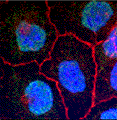Biochemistry, Department of
Document Type
Article
Date of this Version
2016
Citation
Published in Journal of Microbiological Methods 131 (2016), pp 113–121.
doi 10.1016/j.mimet.2016.10.010
Abstract
Bacterial and archaeal genomes can contain 30% or more hypothetical genes with no predicted function. Phylogenetically deep-branching microbes, such as methane-producing archaea (methanogens), contain up to 50% genes with unknown function. In order to formulate hypotheses about the function of hypothetical gene functions in the strict anaerobe, Methanosarcina acetivorans, we have developed high-throughput anaerobic techniques to UV mutagenize, screen, and select for mutant strains in 96-well plates. Using these approaches we have isolated 10 mutant strains that exhibit a variety of physiological changes including increased or decreased growth rate relative to the parent strain when cells use methanol and/or acetate as carbon and energy sources. This method provides an avenue for the first step in identifying new gene functions: associating a genetic mutation with a reproducible phenotype. Mutations in bona fide methanogenesis genes such as corrinoid methyltransferases and proton-translocating F420H2:methanophenazine oxidoreductase (Fpo) were also generated, opening the door to in vivo functional complementation experiments. Irradiation-based mutagenesis such as from ultraviolet (UV) light, combined with modern genome sequencing, is a useful procedure to discern systems- level gene function in prokaryote taxa that can be axenically cultured but which may be resistant to chemical mutagens.
Includes supplementary tables & figures
Figs S1-S3 & Figs S1-S8
Included in
Biochemistry Commons, Biotechnology Commons, Other Biochemistry, Biophysics, and Structural Biology Commons



Comments
Copyright © 2016 Elsevier B.V. Used by permission.